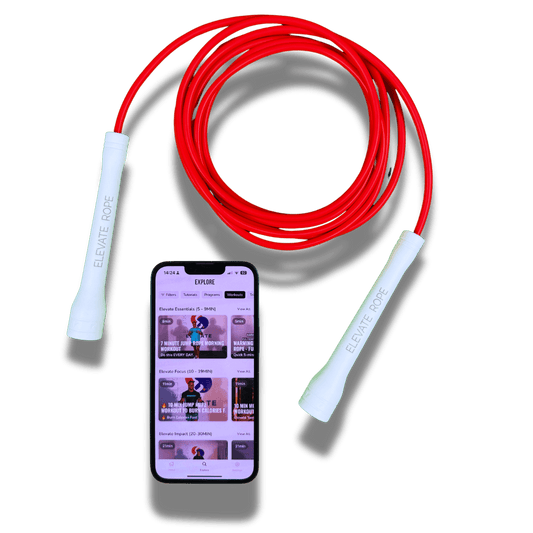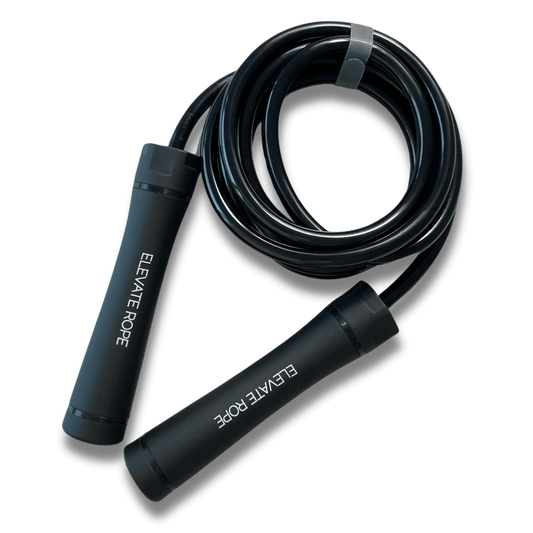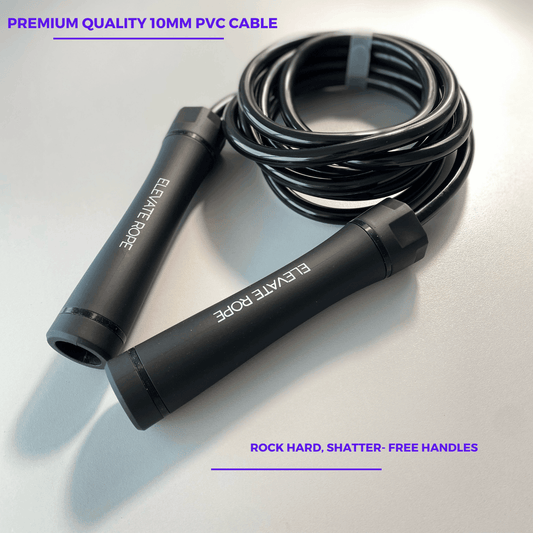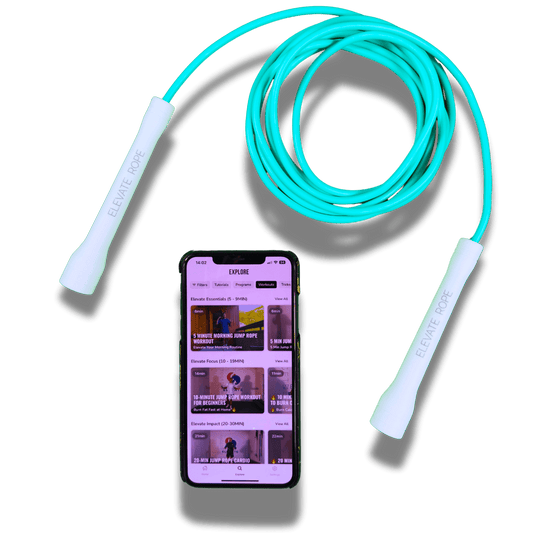Introducción — El poder del circuito de cuerda para saltar
Los entrenamientos de circuito con cuerda para saltar son el arma secreta de atletas, profesionales ocupados y entusiastas del fitness que quieren resultados máximos en tiempo mínimo. En lugar de pasar horas en sesiones separadas de cardio y fuerza, este método de entrenamiento combina intervalos de cuerda para saltar con movimientos de peso corporal — desbloqueando una quema total del cuerpo que mejora la resistencia, coordinación y fuerza simultáneamente.
En un mundo lleno de rutinas de fitness complicadas y membresías de gimnasio, tu cuerda y tu cuerpo son todo lo que realmente necesitas. Un circuito de cuerda para saltar desafía tu sistema cardiovascular mientras mantiene tus músculos activos, entregando resultados visibles y duraderos.
Ya sea que tu objetivo sea desarrollar músculo magro, mejorar la resistencia o superar una meseta de fitness, este tipo de entrenamiento cumple. ¿Y lo mejor? Puedes hacerlo en cualquier lugar — desde tu sala hasta el parque, o incluso durante un viaje.
Dato rápido: Los estudios muestran que saltar la cuerda quema hasta 10–15 calorías por minuto — combínalo con ejercicios de peso corporal, y tu metabolismo se dispara mucho después de que termina tu entrenamiento.
👉 ¿Ya tienes confianza con tus habilidades con la cuerda? Mejora con Trucos Intermedios de Cuerda para Saltar.

Por qué deberías combinar la cuerda para saltar y el entrenamiento con peso corporal
1. Construye fuerza y resistencia juntos
La mayoría de los entrenamientos se enfocan en uno u otro — resistencia o fuerza. Un circuito de cuerda para saltar ofrece ambos. Saltar construye capacidad aeróbica, mientras que movimientos con el peso corporal como flexiones, sentadillas y planchas desafían tus músculos mediante resistencia controlada. El cambio constante entre cardio y movimientos de potencia mejora el rendimiento atlético y la fuerza funcional.
2. Aumenta la quema de calorías y la eficiencia
Debido a que la frecuencia cardíaca se mantiene elevada durante todo el entrenamiento, quemas más calorías en menos tiempo. Incluso durante los intervalos de fuerza, tu cuerpo permanece en un modo metabólico de "afterburn" — lo que significa que continúas quemando calorías mucho después de terminar tu sesión.
3. Mejora la coordinación y el enfoque mental
El ritmo de la cuerda obliga a la sincronización entre tu cerebro y músculos. Añadir patrones complejos de peso corporal — como saltos con zancada o escaladores — mejora la coordinación neuromuscular, ayudándote a moverte con más eficiencia en todas las actividades.
4. Equipamiento mínimo, máxima flexibilidad
Todo lo que necesitas es tu Elevate Rope y un pequeño espacio abierto. No se requieren pesas caras ni un gimnasio. Esa libertad hace que el entrenamiento en circuito con cuerda sea ideal para quienes valoran la flexibilidad, simplicidad y constancia.
Cómo funciona un circuito de salto con cuerda
Un circuito es una serie de ejercicios realizados uno tras otro con descansos mínimos. En un circuito de salto con cuerda, alternas entre intervalos de salto con cuerda y movimientos con peso corporal.
Cada ronda desafía diferentes grupos musculares y sistemas energéticos, evitando que tu cuerpo se adapte y que tu mente se aburra.
- 45 segundos de salto con cuerda
- 30 segundos de movimiento con peso corporal
- Descanso de 15–30 segundos
- Repetir durante 4–5 rondas
Eso es un circuito completo. Dependiendo de tu nivel de condición física, puedes completar 2–3 circuitos por entrenamiento.
Ejemplo de temporización
| Nivel de condición física | Saltar la cuerda | Peso corporal | Descansar | Rondas |
| Principiante | 30 seg | 20 seg | 30 seg | 3 |
| Intermedio | 45 seg | 30 seg | 20 seg | 4 |
| Avanzado | 60 seg | 30 seg | 15 seg | 5+ |
Esta estructura ofrece tanto los beneficios de acondicionamiento del cardio de alta intensidad como el compromiso muscular del entrenamiento de resistencia.
El circuito perfecto de cuerda para saltar de cuerpo completo
Prueba este circuito de cuerpo completo de 25 minutos que trabaja todos los grupos musculares principales mientras mantiene tu ritmo cardíaco en la zona óptima de entrenamiento.
| Redondo | Ejercicio con cuerda para saltar | Ejercicio con peso corporal | Objetivo |
| 1 | Rebote básico (45 seg) | Flexiones (30 seg) | Pecho y brazos |
| 2 | Balanceos laterales (45 seg) | Sentadillas aéreas (30 seg) | Piernas y glúteos |
| 3 | Paso de boxeador (45 seg) | Toques de hombro en plancha (30 seg) | Núcleo y estabilidad |
| 4 | Rodillas altas (45 seg) | Zancadas con salto (30 seg) | Potencia explosiva |
| 5 | Dobles saltos (45 seg) | Burpees (30 seg) | Finalizador de cuerpo completo |
💡 Consejo: Realiza el circuito dos veces, descansando un minuto entre rondas.
Desarrollarás resistencia, agilidad y control total del cuerpo — todo mientras te diviertes y mantienes el ritmo.

Consejos de técnica para máxima eficiencia
Incluso la mejor rutina puede no rendir si tu técnica falla. Aquí están los fundamentos clave para perfeccionar antes de intensificar tu circuito:
- Mantén los codos pegados al cuerpo — el movimiento viene de las muñecas, no de los brazos.
- Aterriza suavemente sobre las puntas de los pies para absorber el impacto.
- Mantén una postura recta con el core activado durante cada serie.
- Controla la respiración: inhala por la nariz, exhala por la boca para estabilizar tu ritmo.
- Modifica cuando sea necesario: cambia zancadas de salto por zancadas reversas, o rodillas altas por pasos alternos si estás fatigado.
Cómo progresar en tus circuitos de salto con cuerda
La progresión te mantiene motivado y asegura una adaptación continua.
Principiantes
Comienza con tres rondas usando rebotes básicos y movimientos simples con el peso corporal. Enfócate en el control, no en la velocidad.
Intermedio
Incorpora variaciones como balanceos laterales, pasos de boxeador y sentadillas con salto. Añade intensidad acortando los períodos de descanso o usando una cuerda más rápida.
Avanzado
Usa cuerdas con peso para aumentar la resistencia, realizar dobles saltos y extender la duración de tu circuito. Combina movimientos avanzados de fuerza como flexiones con liberación de manos o sentadillas pistol para un desafío de élite.
💡 Consejo Profesional: Alterna entre cuerdas con cuentas y cuerdas de velocidad para mejorar el ritmo y la sincronización.
Explora nuestra Comparación de Cuerda con Cuentas vs Cuerda de Velocidad para encontrar la cuerda ideal para tus objetivos.

Errores Comunes a Evitar
Incluso los atletas experimentados caen en hábitos que limitan los resultados o causan lesiones.
1. Calentamientos de Salto
Saltar la cuerda involucra intensamente los tobillos, rodillas y hombros. Siempre comienza con un calentamiento de movilidad de 5 minutos: círculos de brazos, rotaciones de cadera y saltos ligeros.
2. Longitud Incorrecta de la Cuerda
Un tamaño incorrecto de la cuerda causa tropiezos y forma ineficiente. Párate en el centro de tu cuerda — las manijas deben alcanzar la altura del pecho. Aprende cómo en nuestra Guía de Configuración de la Cuerda.
3. Sobreentrenamiento
Los entrenamientos en circuito son intensos por naturaleza. Hacerlos a diario puede sobrecargar las articulaciones y músculos. Entrena 3–4 veces por semana con días adecuados de recuperación entre medio.
4. Olvidar la Forma Bajo Fatiga
A medida que la fatiga se instala, la postura y el ritmo pueden deteriorarse. Prioriza la forma sobre la velocidad — las repeticiones de calidad siempre superan a la cantidad.
Recuperación y Movilidad Después de los Circuitos
Después de terminar tu última ronda, no solo sueltes la cuerda — la recuperación es donde ocurre el progreso.
Rutina de Enfriamiento
- 1–2 minutos de salto lento (rebote básico)
- 30 seg de respiración profunda — inhala por 4, exhala por 6
- Estira las pantorrillas, los hombros y los flexores de la cadera
- Termina con un rodillo de espuma ligero si está disponible
Esto ayuda a prevenir las periostitis y el dolor mientras mejora la movilidad articular a largo plazo.
👉 Termina tu entrenamiento con nuestro entrenamiento de recuperación — diseñado específicamente para saltadores para relajarse y reiniciar.
Plan de Progresión de 4 Semanas de Ejemplo
| Semana | Objetivo | Enfoque en la cuerda | Enfoque en el peso corporal |
| 1 | Construye la base | Rebote básico, balanceo lateral | Sentadillas, flexiones |
| 2 | Añade resistencia | Paso de boxeador, rodillas altas | Zancadas, planchas |
| 3 | Aumenta la intensidad | Saltos dobles | Sentadillas con salto, burpees |
| 4 | Rendimiento máximo | Intervalos con cuerda lastrada | Combinaciones complejas (escaladores + flexiones) |
Repite este ciclo añadiendo resistencia o disminuyendo el tiempo de descanso para mejorar continuamente la resistencia y tonificar.
Por qué los Circuitos de Salto con Cuerda Superan a los Entrenamientos Tradicionales
Fitness Funcional
Los circuitos de salto con cuerda imitan patrones de movimiento de la vida real — coordinación, sincronización y equilibrio — en lugar de entrenamiento muscular aislado.
Eficiencia de costos
Solo necesitas un equipo que quepa en tu mochila. Compáralo con una membresía de gimnasio o un equipo voluminoso para casa.
Puedes lograr el mismo beneficio cardiovascular que un trote de 30 minutos en solo 12–15 minutos de saltar la cuerda. Añade algunas flexiones y sentadillas, y tu entrenamiento completo estará listo.
Divertido y Sostenible
El ritmo y el desafío del flujo con cuerda te mantienen motivado a largo plazo. No es solo entrenamiento — es juego con propósito.
Prepárate para el Éxito
Elegir la cuerda adecuada transforma tu experiencia de circuito.
- Cuerda con cuentas: Perfecta para control, aprender ritmo y combinaciones de estilo libre.
- Cuerda de velocidad: Diseñada para transiciones rápidas, resistencia y quema cardiovascular.
- Cuerda con peso: Ideal para desarrollar fuerza y explosividad en la parte superior del cuerpo.
🎯 Consigue Ascent MAX — Ahorra €20
Mejora tu equipo de entrenamiento con la misma cuerda en la que confían atletas profesionales y saltadores de Elevate Family en todo el mundo.
Consejos de Seguridad para un Progreso Sostenible
- Entrena sobre superficies lisas (alfombrillas de goma o pisos de madera) para reducir el estrés en las articulaciones.
- Mantén tu postura erguida; no te encorves hacia adelante.
- Reemplaza las cuerdas si el recubrimiento muestra desgaste — la seguridad es lo primero.
- Mantente hidratado y escucha a tu cuerpo.
Tu cuerda es una herramienta de empoderamiento — trátala como una extensión de ti mismo.
Conclusión — Eleva Cada Repetición
Los entrenamientos de circuito con cuerda combinan el poder cardiovascular del salto con los beneficios de fuerza del entrenamiento con peso corporal — creando una sinergia perfecta de resistencia, coordinación y control muscular.
Con solo 20–30 minutos unas pocas veces por semana, desarrollarás resistencia, agilidad y fuerza magra mientras mantienes tus entrenamientos divertidos y sostenibles.
Sin gimnasio, sin excusas. Solo tú, tu cuerda y la gravedad.
Así que toma tu Elevate Rope, elige un circuito y prepárate para moverte de manera diferente — un salto, una repetición, un avance a la vez.














